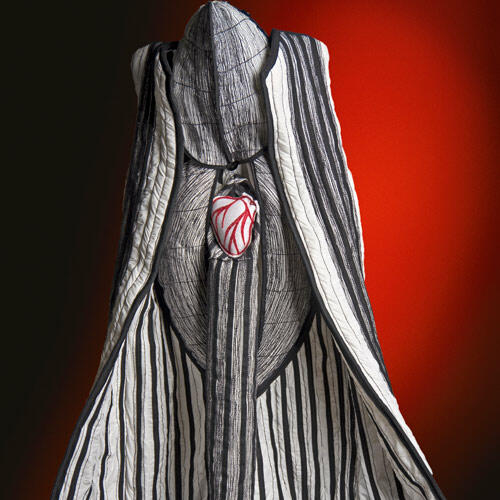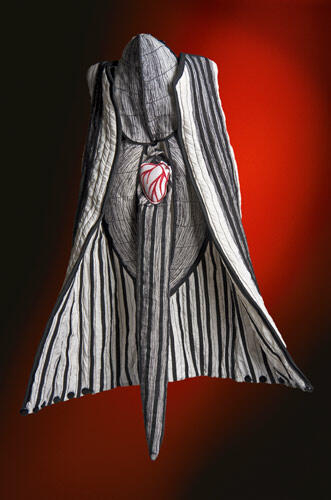Carmen Ramírez
at 13 Jeannette Mariani, Paris
When one enters the exhibition venue, one cannot imagine the visual dialogue that will be established between the visitor and the series of works on display. Under the title of “Cuerpos desdoblados” (“Split Bodies”), some of Ramírez’s most revealing works appear before the spectator. Pieces of clothing that open up and hide, uninhabited but full of significance, waiting to be worn by those who observe, epitomize a common search: they propose a practice aimed at self-encounter as opposed to failed encounters, and crisis as a necessary and individual process to understand and accept otherness. They pose reflection regarding the communicational conflict that contemporary man is faced with and the impossibility to create true and essential bonds, questioning the slipping away of everyday life as a virtual and immediate experience.

On observing these beings made of cloth, these strange silhouettes; on viewing these intriguing personages it would be interesting to relinquish judgment and interrogate Ramírez’s work. Abstraction? Figuration? A dream, a nightmare, or a reality? A paradise with an aura of goodness, or a purgatory filled with disoriented souls? Hard to imagine, the work of this artist, which is unclassifiable, resists all forms of sensible analysis. Must one be guided by emotions and allow oneself to be absorbed by its world of beauty in order to understand it? And accept to experience this baffling feeling within a universe that is assembled and disassembled at every moment, with every new glance?
Divided between her activities as a teacher and as an artist, Ramírez has invented a personal oeuvre, in which the time dimension is fundamental and functions modifying the past from the present and vice-versa. There is a ritual aspect in her weavings, which is the product of a childhood surrounded by a family of immigrants, in which she recalls almost as a rarity the matriarchal prevalence of women (grandmother, aunts, mother), sharing the routine of sewing. The work attempts to discover the time of this memory in order to interconnect us through a private encounter between the self and the other that takes place through the rite of sewing, a solitary task, feminine and complementary, almost shamanic. Thus, her work is transformed into a liturgy of seclusion which, from its mute-silent formalism, denounces, declares, and reveals an oral and talking being, for whoever wants to listen.
Her works are “things”, a visible result of the imprint “of what remains” of an exploration. Works that contain the fragility of their genesis, the memories and symbols in filigree, that condense in themselves time dilated into an infinite succession of lapses that express themselves simultaneously, without any distinctions between present, past and future. In an attempt to emancipate memories, her gesture becomes an escape and her work is transformed into ideas, concerns, and thoughts.
Considering the fabric the container of that universe, she organizes the links, composes an element-object and thus creates a work. An indispensable matrix, the fabric allows her to generate a panel of pieces expressing in their searches the strength, the beauty, and the violence of every living being. Her work may be perceived as a certain form of resistance, in a saturated, incoherent world in permanent movement. An intimist in her work, she is not afraid of adopting materials and forms that lead her to certain marginality, addressing themes that she strips to their essence in order to reach the essence of the human condition. Ramírez observes and listens to the language of the threads, to what they transmit to her; thus, before she acts, she draws and delimits the invisible. She pursues the emergence of a presence that offers itself as an absence. She flirts with silence and oblivion, with the invisible element in the space that hosts those forms.
Her visual language proposes an inverted gaze on social conventions and confronts things with the issue of human time, taking the spectator beyond a simple confrontation. It is not merely a question of constructing images that conjure the real, but of showing that the reality of the image is the access to reality, where all figuration represents the will to transcend. Carmen Ramírez invites us to discover her testimonies of a melancholic universe. Midway between mental projection and reflection on the visible/invisible, she shows the complexity of the human being captured in a dense and fleeting instant.
-
 Untitled, 2010. Polyester thread, sewn and embroidered cotton fabric, recovered polyester fiber. Courtesy the artist.
Untitled, 2010. Polyester thread, sewn and embroidered cotton fabric, recovered polyester fiber. Courtesy the artist.
Sin título, 2010. Hilo poliéster, tela de algodón cosida y bordada, tela poliéster de recuperación. Cortesía de la artista.




